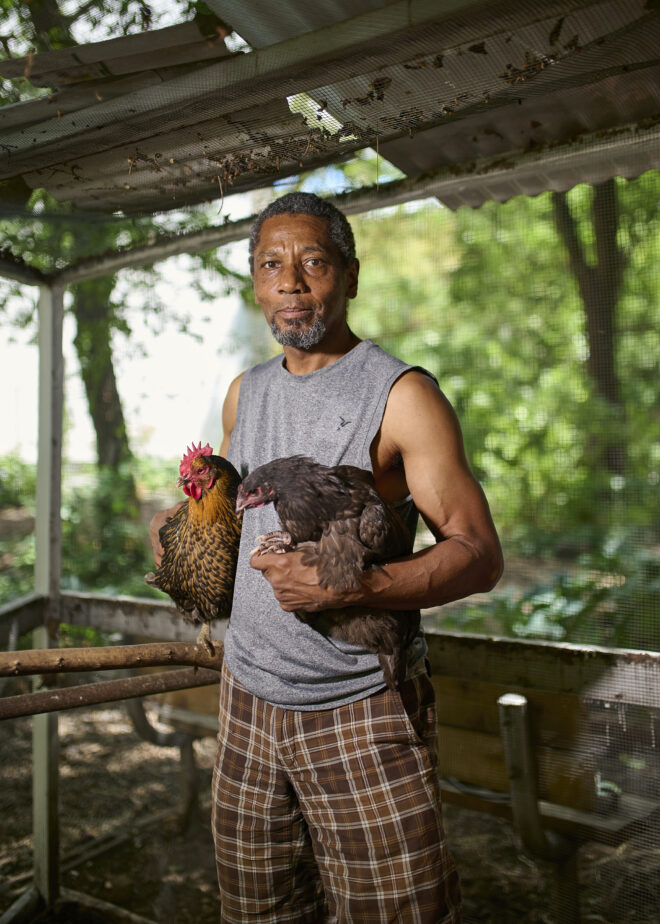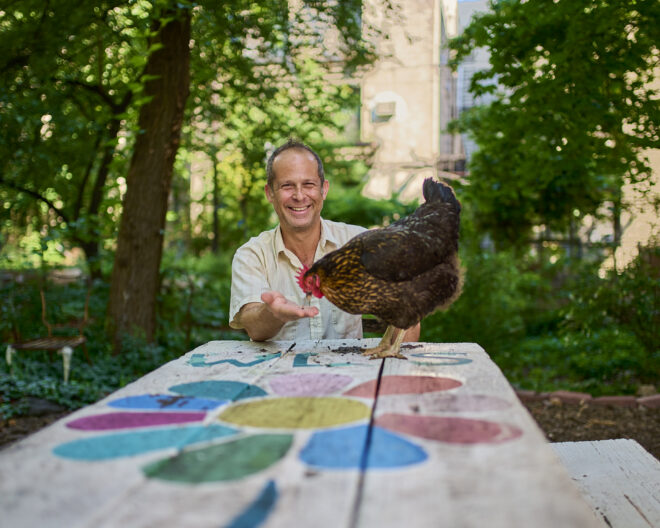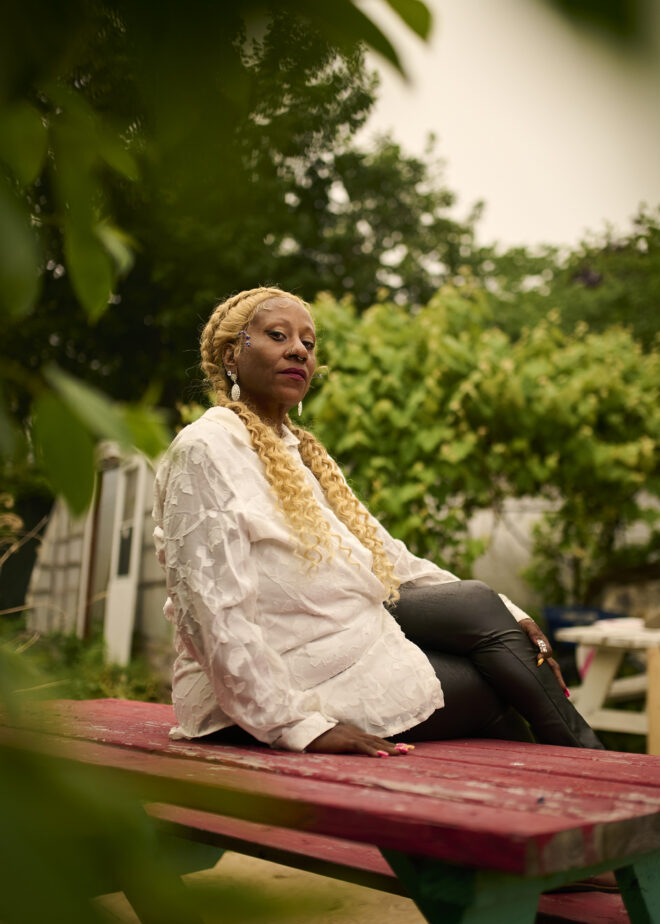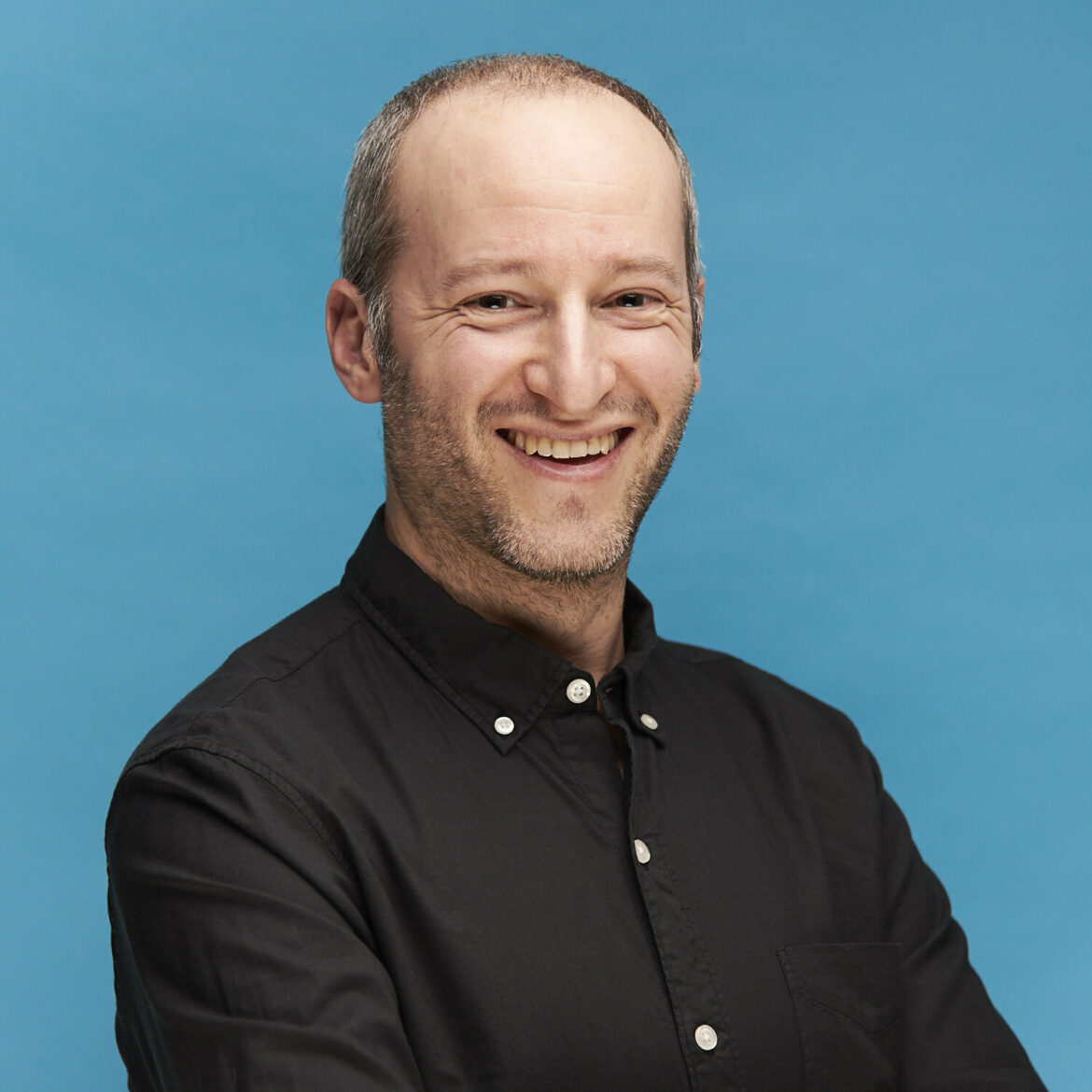Zachary Schulman is a photographer whose work has appeared at the Museum of the City of New York and has been featured in publications including The New York Times, Vice, Financial Times, Gothamist, Earth Island Journal, The Wall Street Journal Magazine, Town & Country, Thrillist, NowThis News, Colorlines, Civil Eats, City & State New York, and more. His current exhibition, The Community Gardener Portrait Project: New York City, is showing at The Arsenal Gallery in Central Park, Manhattan from January 25, 2024 until March 14, 2024.
Before becoming a professional photographer, Zachary spent fourteen years working with community gardeners and progressive nonprofits in New York City. During that time, he honed his ability to listen attentively and observe deeply, which are skills he now infuses into his photographs to amplify the voices of those same organizations.

Food Policy Center: Thank you for taking the time for this interview. To start, how have your experiences with community gardeners in NYC influenced your perspective on the intersection of photography, food, and social change?
Zachary Schulman: Something I learned early on, before I started working as a photographer, is that food is both an important end, in and of itself, and also an organizing tool. When I first worked at Green Guerillas as a community organizer, we were working on a campaign with community gardeners in Central Brooklyn to identify space within gardens where we could increase food production for two purposes: increasing community food security and increasing garden membership. While retaining existing members, we also drew in more people who wanted to grow food. Simultaneously, we donated surplus produce from the gardens to nearby emergency food providers, such as food pantries and soup kitchens.
As for the intersection of photography and social change, my practice fits within the long tradition of utilizing portrait photography and oral histories as tools in service to movements for social justice. I believe that this approach emphasizes the skills, wisdom, and achievements of participants. Captioning the portraits with quotes from interviews makes those participants storytellers and historians.
FPC: Your upcoming exhibition, “The Community Gardener Portrait Project: New York City,” showcases portraits and interviews with 34 community gardeners. Can you share the inspiration behind that project and what you hope viewers will take away from it? What have you learned through working on this project, and what surprised you the most?
ZS: Even before I became a community gardener I was inspired by community gardens as a hub for so many powerfully positive elements: community stewardship of green space; localized, culturally relevant food production; ecological restoration, and community cultural space. It was these elements, and more that inspired me to get involved with community gardens more than twenty years ago. Many years later, when I became a professional photographer, I was inspired by the suggestion of Greg Anderson, a fellow gardener who is deeply involved with the Walt L. Shamel Community Garden in Crown Heights, Brooklyn, to start a portrait series of community gardeners. As I began to work on the project in 2018 and share the portraits with photographer colleagues who were largely unfamiliar with community gardening, I received a lot of feedback indicating that they wanted to know, to see, to hear more from those gardeners. They wanted the background, they wanted the stories. I thought a lot about this, and about my experience having worked with community gardens for so long, and having done some work collecting oral histories when I worked at the Brooklyn Queens Land Trust, and I decided to caption the images with the gardeners’ words, which I pulled from interviews.

I really want to celebrate the work that community gardeners have been doing for decades. I hope that people see those accomplishments and that they will be energized to support their local community gardens by volunteering, joining, or contributing in ways that strengthen the community gardening movement.
Over the course of this project, I’ve been both surprised and delighted by how positive a mental health impact community gardens have on the people who are involved. So many people talk about how their stress, anxiety, and even their physical pains dissipate when they’re gardening.
FPC: With GreenThumb sustaining more than 550 community gardens, how do you see these spaces contributing to neighborhood pride and the broader social fabric of New York City?
ZS: It’s been my experience that planting or working in a community garden is one of the easiest ways for people to meet and connect with their neighbors, which is also one of the most powerful factors contributing to strengthening the social fabric of any area. Community gardens are quintessential third places. On top of that, you don’t need to buy a drink or pay a cover charge to enjoy these pockets of green. In a city where so much is controlled by corporations and bureaucracies, I think that New Yorkers love having a direct, tangible, positive impact on something close to home. And we all benefit directly from it as well. Certainly the air is cleaner, and the temperature extremes are moderated by the gardens, and so on with the many benefits of gardens. Many of the gardens also produce food, and gardeners love to share, so oftentimes visitors go home fresh herbs and more given to them by the members. .
FPC: Could you highlight a specific portrait from the exhibition that holds particular significance for you, and share the story behind it?

ZS: This is so difficult because I have so many favorites. Yonnette Flemming’s portrait stands out to me for many reasons, but I’ll just speak to one of the feelings that was in the air that day. We were at the Hattie Carthan Community Garden in Bed Stuy, Brooklyn. It was the evening of June 6th, and a thick layer of wildfire smoke from Canada had just blown in as Yonnette was sharing some deep wisdom with me. The sky was darkening, turning orange, and everything started to smell of woodsmoke. The mood and the air felt intense, and both the color of the sky and the intensity of the moment come through in the portrait.
FPC: As an artist contributing to social change, how do you believe the exhibition aligns with the mission of GreenThumb to support and preserve open spaces in urban environments?
ZS: I’ve already heard people say that after viewing the exhibit they were eager to join their local community garden. That’s one of the main goals of the project and this exhibition: strengthening the community garden movement, and that means getting more people involved with community gardens.
FPC: How do you approach mentoring students who might be drawn to mission-focused art?
ZS: I’m not currently mentoring anyone, but I’m certainly willing to talk with anyone who is interested!
FPC: How does your photography capture the essence of long-term stewardship and creation in community gardens across all five boroughs of NYC?
ZS: I think of my work as showcasing a small slice of the beauty of the gardens and some highlights of the gardeners’ stories: starting the gardens, how the gardens impact them individually and as a community, and how the gardens are part of larger social movements. These are themes that emerge in our conversations time and time again.
FAST FACTS
Grew up in: Brookline Massachusetts and Westchester, New York
City or town you call home: Brooklyn
Job title: Photographer
Background and education: Environmental Studies Major at University of Michigan
One word you would use to describe our food system: Apartheid
Food policy hero: Karen Washington
Your breakfast this morning: Scrambled eggs with Doña Julia cheese and scallions; homemade rolls with butter and persimmon jam; and a cabbage carrot slaw with preserved lemon and Buddha’s Hand citron.
Favorite food: Cheese
Favorite food hangout: The wood fired pizza oven at Walt L. Shamel Community Garden
Food policy social media must follow: @Seedkeeping on IG


